Combustion Test for the Smallest Reciprocating Piston Internal Combustion Engine with HCCI on the Millimeter Scale
Abstract
:1. Introduction
2. Materials and Methods
3. Results and Discussions
3.1. Compression Ratio
3.2. Thermal State
3.3. Intake Pressure
4. Conclusions
Author Contributions
Funding
Institutional Review Board Statement
Informed Consent Statement
Data Availability Statement
Conflicts of Interest
References
- Ju, Y.; Maruta, K. Microscale combustion: Technology development and fundamental research. Prog. Energy Combust. Sci. 2011, 37, 669–715. [Google Scholar] [CrossRef]
- Wan, J.; Fan, A. Recent progress in flame stabilization technologies for combustion-based micro energy and power systems. Fuel 2021, 286, 119391. [Google Scholar] [CrossRef]
- Mahmud, M.A.P.; Bazaz, S.R.; Dabiri, S.; Mehrizi, A.A.; Asadnia, M.; Warkiani, M.E.; Wang, Z.L. Advances in MEMS and microfluidics-based energy harvesting technologies. Adv. Mater. Technol. 2022, 7, 2101347. [Google Scholar] [CrossRef]
- Chen, W.L.; Currao, G.; Li, Y.H.; Kao, C.C. Employing Taguchi method to optimize the performance of a microscale combined heat and power system with Stirling engine and thermophotovoltaic array. Energy 2023, 270, 126897. [Google Scholar] [CrossRef]
- E, J.Q.; Ding, J.J.; Chen, J.W.; Liao, G.L.; Zhang, F.; Luo, B. Process in micro-combustion and energy conversion of micro power system: A review. Energy Convers. Manag. 2021, 246, 114664. [Google Scholar]
- Velidi, G.; Yoo, C.S. A Review on flame stabilization technologies for UAV engine micro-meso scale combustors: Progress and challenges. Energies 2023, 16, 3968. [Google Scholar] [CrossRef]
- Formosa, F.; Frechette, L.G. Scaling laws for free piston Stirling engine design: Benefits and challenges of miniaturization. Energy 2013, 57, 796–808. [Google Scholar] [CrossRef]
- Dessornes, O.; Landais, S.; Valle, R.; Fourmaux, A.; Burguburu, S.; Zwyssig, C.; Kozanecki, Z. Advances in the Development of a Microturbine Engine. J. Eng. Gas Turbines Power 2014, 136, 071201. [Google Scholar] [CrossRef]
- Wang, W.; Zuo, Z.; Liu, J. Miniaturization limitations of rotary internal combustion engines. Energy Convers. Manag. 2016, 112, 101–114. [Google Scholar] [CrossRef]
- Shi, B.; Yu, H.; Zhang, J. The effects of the various factors and the engine size on micro internal combustion swing engine (MICSE). Appl. Therm. Eng. 2018, 144, 262–268. [Google Scholar] [CrossRef]
- Lungu, C.; Disseau, M.; Stubbs, D.; Jagoda, J.; Scarborough, D.E. An experimental and theoretical investigation of a small, high aspect-ratio, free-piston, two-stroke engine. Propuls. Power Res. 2020, 9, 326–343. [Google Scholar] [CrossRef]
- Maimani, F.; Calderon, A.A.; Yang, X.F.; Rigo, A.; Ge, J.Z.; Perez-Arancibia, N.O. A 7-mg miniature catalytic-combustion engine for millimeter-scale robotic actuation. Sens. Actuators A Phys. 2022, 341, 112818. [Google Scholar] [CrossRef]
- Lurie, E.; Kribus, A. Analysis of a Microscale ‘Saturation Phase-Change Internal Carnot Engine’. Energy Convers. Manag. 2010, 51, 1202–1209. [Google Scholar] [CrossRef]
- Amnache, A.; Liamini, M.; Gauthier, F.; Beauchesne-Martel, P.; Omri, M.; Fréchette, L.G. A MEMS turbopump for high temperature rankine micro heat engines—Part I: Design and fabrication. J. Microelectromech. Syst. 2020, 29, 1278–1292. [Google Scholar] [CrossRef]
- Blantin, J.R.; Polanka, M.D.; Ausserer, J.K.; Baranski, J.A. Correlations for the performance, efficiency, and energy losses for single cylinder, four-cycle internal combustion engines with displaced volumes ranging from 40 to 200 cc. J. Eng. Gas Turbines Power 2023, 145, 031027. [Google Scholar] [CrossRef]
- Raviteja, S.; Ramakrishna, P.A.; Ramesh, A. Performance enhancement of a small two-stroke engine using nitromethane blends. J. Propuls. Power 2019, 35, 520–529. [Google Scholar] [CrossRef]
- Rowton, A.K.; Ausserer, J.K.; Grinstead, K.D.; Litke, P.J.; Polanka, M.D. Measuring Scaling Effects in Small Two-Stroke Internal Combustion Engines. In Proceedings of the SAE/JSAE 2014 Small Engine Technology Conference & Exhibition, Pisa, Italy, 18–20 November 2014; SAE Technical Paper 2014-32-0010. SAE International: Warrendale, PA, USA, 2014. [Google Scholar]
- Tang, G.Z.; Wang, S.B.; Zhang, L.; Shang, H.C. Diagnosis and improvement of combustion characteristics of methanol miniature reciprocating piston internal combustion engine. Micromachines 2020, 11, 96. [Google Scholar] [CrossRef] [PubMed]
- Menon, S.; Cadou, C.P. Scaling of miniature piston-engine performance, part 1: Overall engine performance. J. Propuls. Power 2013, 29, 774–787. [Google Scholar] [CrossRef]
- Menon, S.; Cadou, C.P. Scaling of miniature piston engine performance, Part 2: Energy losses. J. Propuls. Power 2013, 29, 788–799. [Google Scholar] [CrossRef]
- Raine, R.R.; Thorwarth, H. Performance and Combustion Characteristics of a Glow-Ignition Two-Stroke Engine. In Proceedings of the SAE 2004 World Congress & Exhibition, Detroit, MI, USA, 8–11 March 2004; SAE Technical Paper 2004-01-1407. SAE International: Warrendale, PA, USA, 2004. [Google Scholar]
- Collair, K.; Floweday, G. Understanding HCCI Characteristics in Mini HCCI Engines. In Proceedings of the 2008 SAE International Powertrains, Fuels and Lubricants Congress, Shanghai, China, 23–25 June 2008; SAE Technical Paper 2008-1-1662. SAE International: Warrendale, PA, USA, 2008. [Google Scholar]
- Manente, V.; Tunestal, P.; Johansson, B. Influence of the Compression Ratio on the Performance and Emissions of a Mini HCCI Engine Fueled with Diethyl Ether. In Proceedings of the Powertrain & Fluid Systems Conference and Exhibition, Rosemont, IL, USA, 29–31 October 2007; SAE Technical Paper 2007-01-4075. SAE International: Warrendale, PA, USA, 2007. [Google Scholar]
- Manente, V.; Tunestal, P.; Johansson, B. Influence of the Wall Temperature and Combustion Chamber Geometry on the Performance and Emissions of a Mini HCCI Engine Fueled with Diethyl Ether. In Proceedings of the SAE World Congress & Exhibition, Detroit, MI, USA, 14–17 April 2008; SAE Technical Paper 2008-01-0008. SAE International: Warrendale, PA, USA, 2008. [Google Scholar]
- Tian, L. Experimental tests and simulations of a 1.5cc miniature glow-ignition two-stroke engine. In Proceedings of the SAE World Congress & Exhibition, Detroit, MI, USA, 13–15 April 2010; SAE Technical Paper 2010-32-0018. SAE International: Warrendale, PA, USA, 2010. [Google Scholar]
- Shang, H.; Zhang, L.; Tang, Z.; Du, B.; Chen, X. Adjusting mixture composition of alcohol-based fuels for improving combustion in a 0.99 cc miniature IC engine. Chem. Eng. Process.-Process Intensif. 2020, 153, 107988. [Google Scholar] [CrossRef]
- Zhang, L.; Zeng, X.R.; Shang, H.C.; Tang, Z.G.; Geng, Y.T.; Han, J.L. Experimental investigation about effect of glow intensity on combustion characteristics for a micro IC engine with platinum wire glow-ignition. Appl. Therm. Eng. 2016, 109, 196–206. [Google Scholar] [CrossRef]
- Shang, H.C.; Zhang, L.; Tang, Z.G.; Chen, X. Experiment on the influence of residual exhaust gas on the combustion characteristics of a miniature engine with platinum wire ignition. ACS Omega 2022, 7, 7393–7402. [Google Scholar] [CrossRef] [PubMed]
- Therkelsen, P.; Dunn-Rankin, D. Small-Scale HCCI Engine Operation. Combust. Sci. Technol. 2011, 183, 928–946. [Google Scholar] [CrossRef]
- Sher, I.; Levinzon-Sher, D.; Sher, E. Miniaturization limitations of HCCI internal combustion engines. Appl. Therm. Eng. 2009, 29, 400–411. [Google Scholar] [CrossRef]
- Wu, Y.Y.; Chen, B.C.; Tsai, H.C.; Liu, T.C. The possibility of running homogeneous charge compression ignition in spark ignition and compression ignition small-scale engines. Proc. Inst. Mech. Eng. Part A J. Power Energy 2011, 225, 579–590. [Google Scholar] [CrossRef]
- Shang, H.C.; Zhang, L.; Chen, B.; Chen, X. Experimental test and thermodynamic analysis on scaling-down limitations of a reciprocating internal combustion engine. Sci. Prog. 2020, 103, 0036850420935731. [Google Scholar] [CrossRef] [PubMed]
- Heywood, J.B. Internal Combustion Engine Fundamentals, 1st ed.; McGraw-Hill: New York, NY, USA, 1988. [Google Scholar]
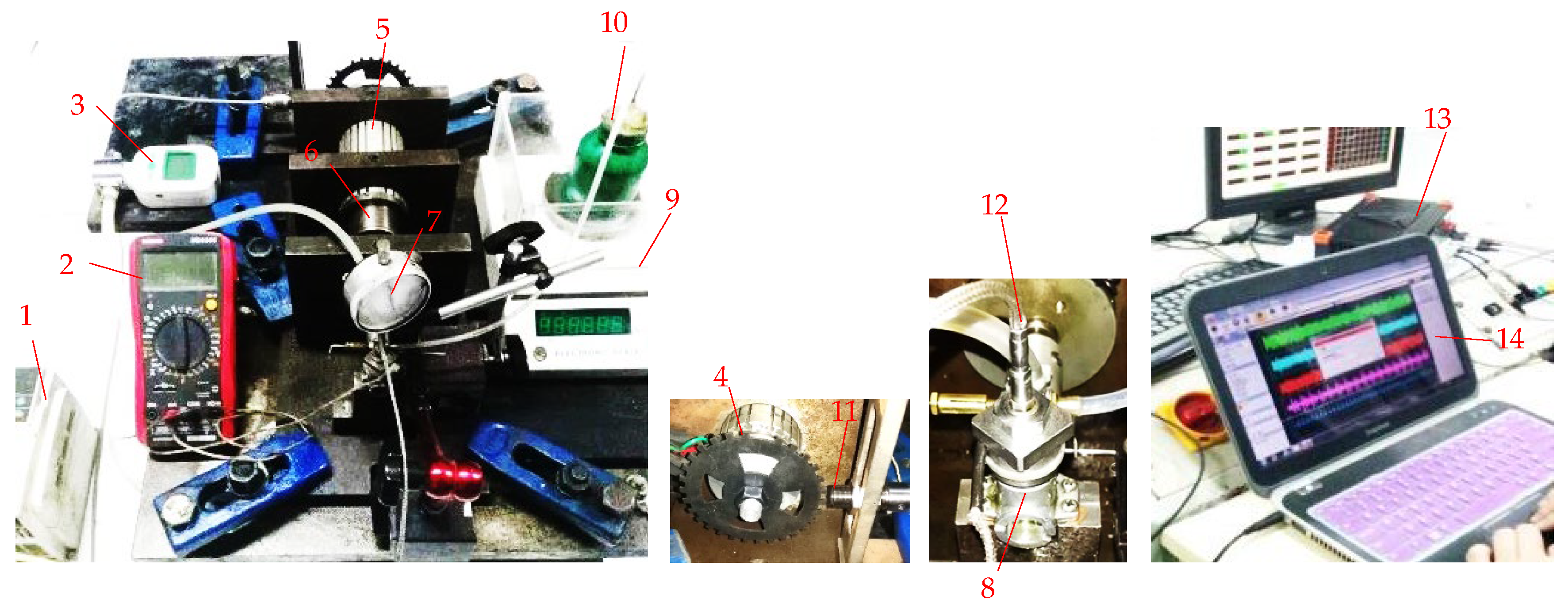
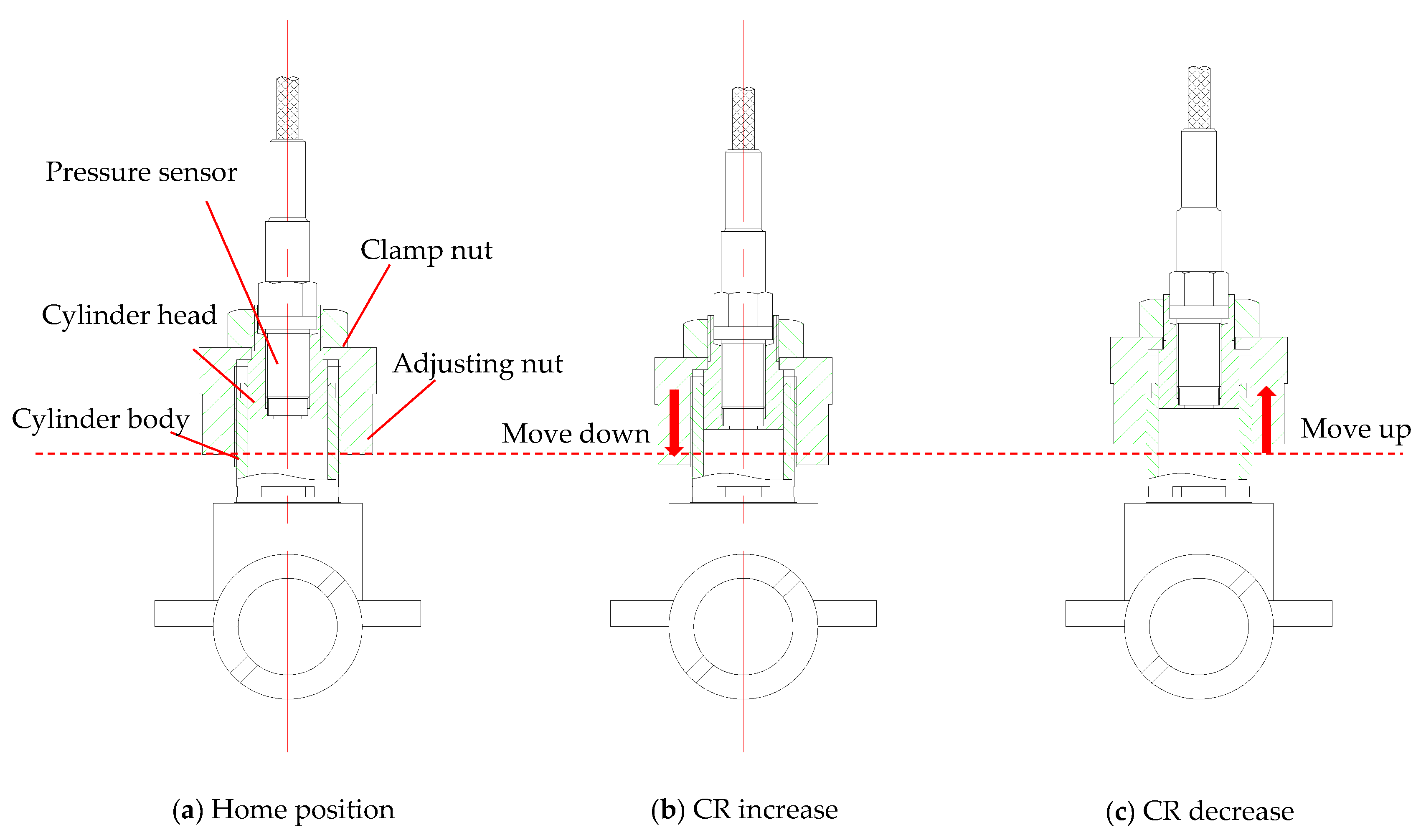

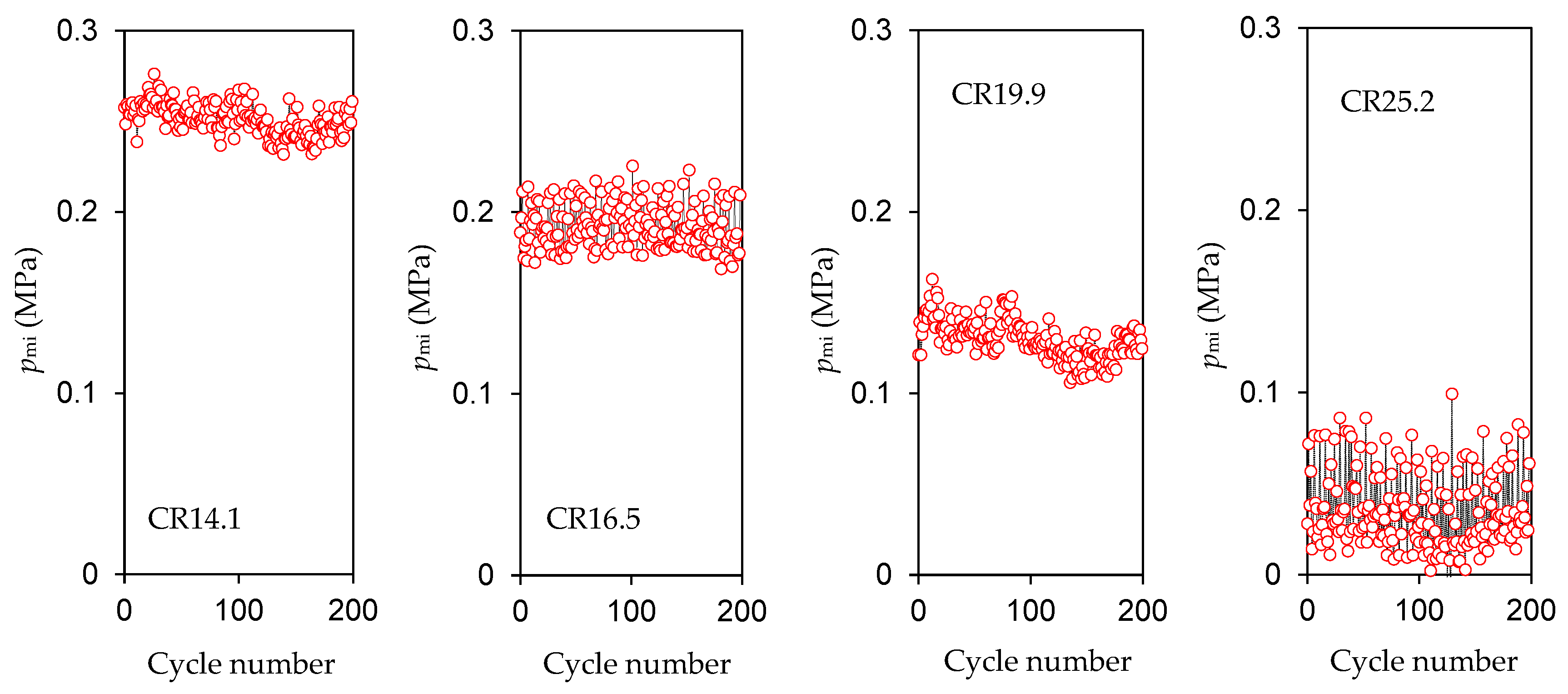
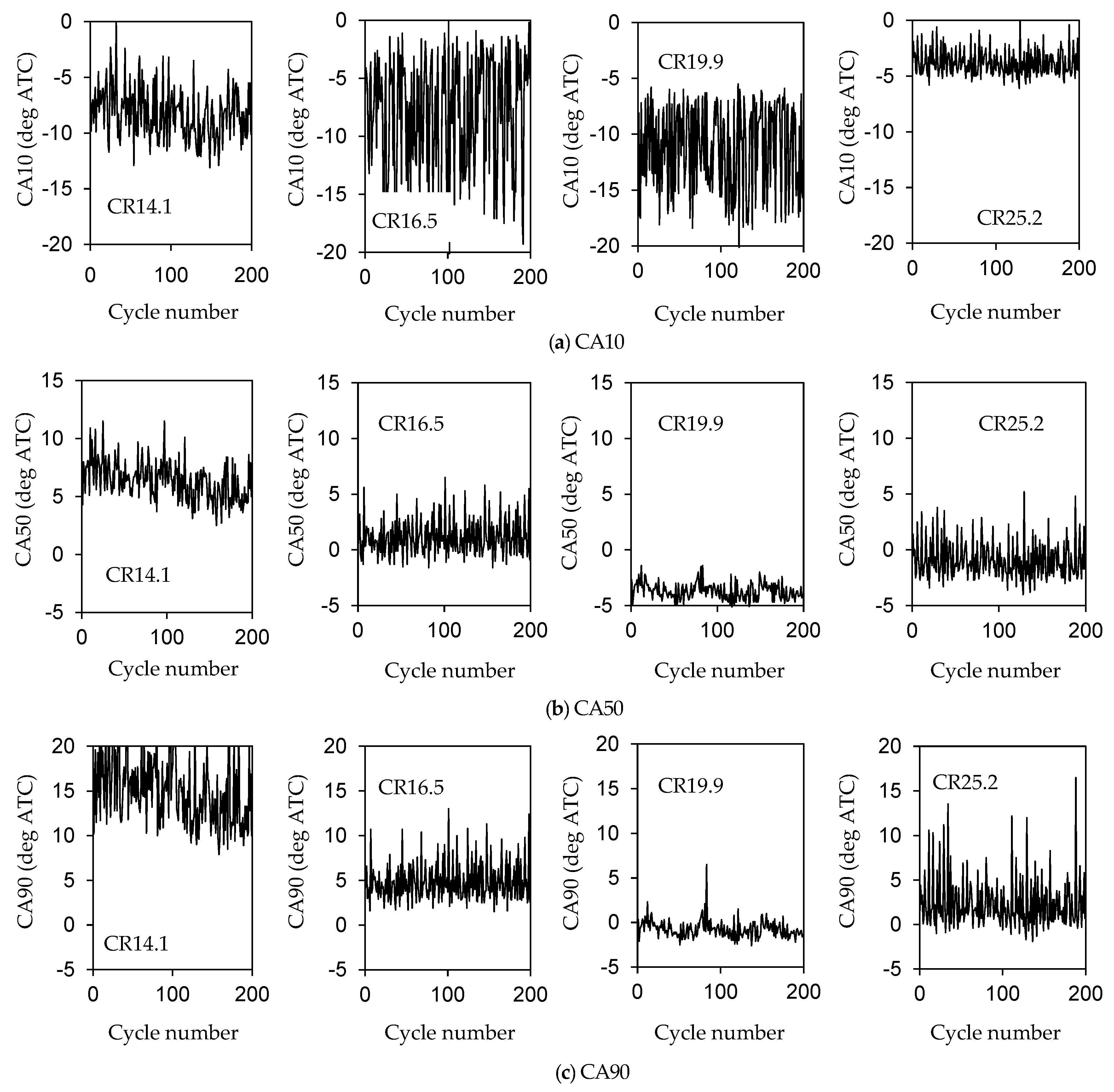

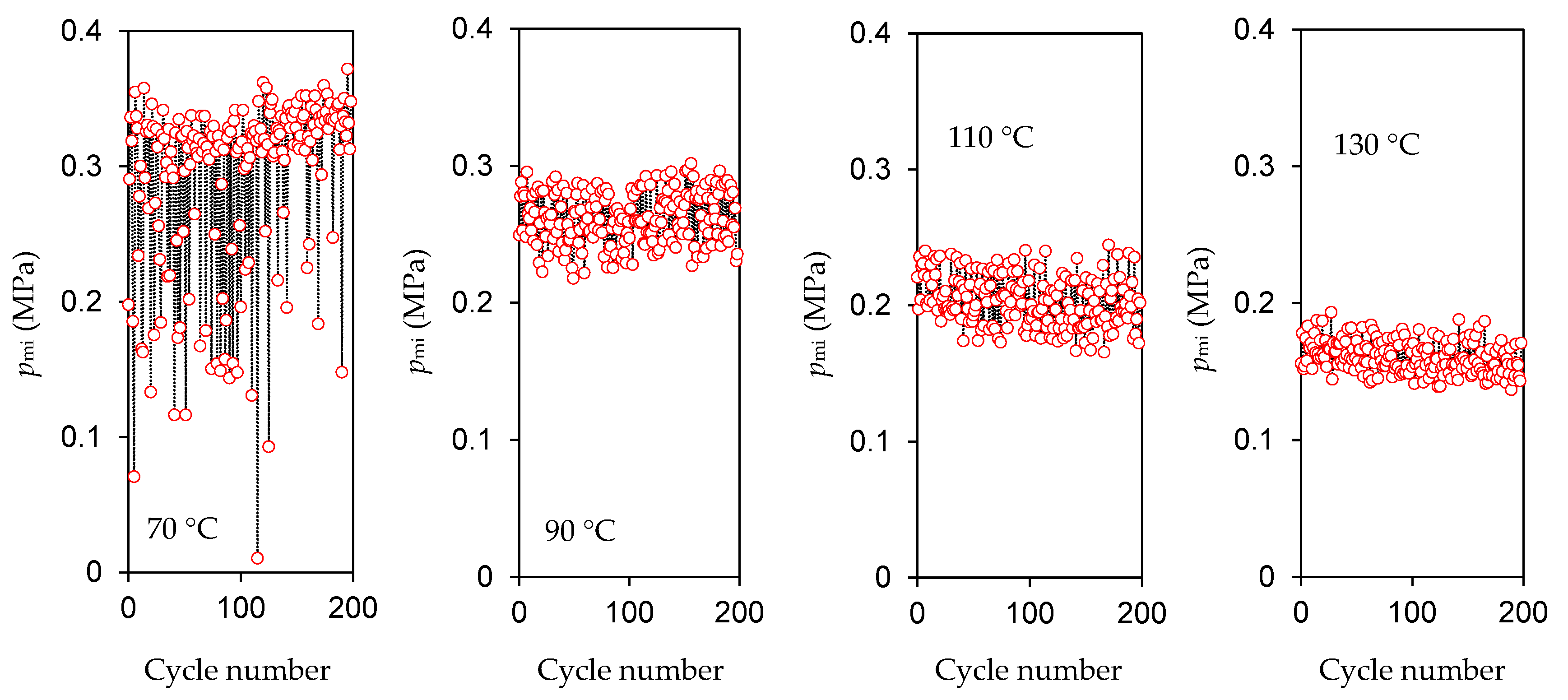
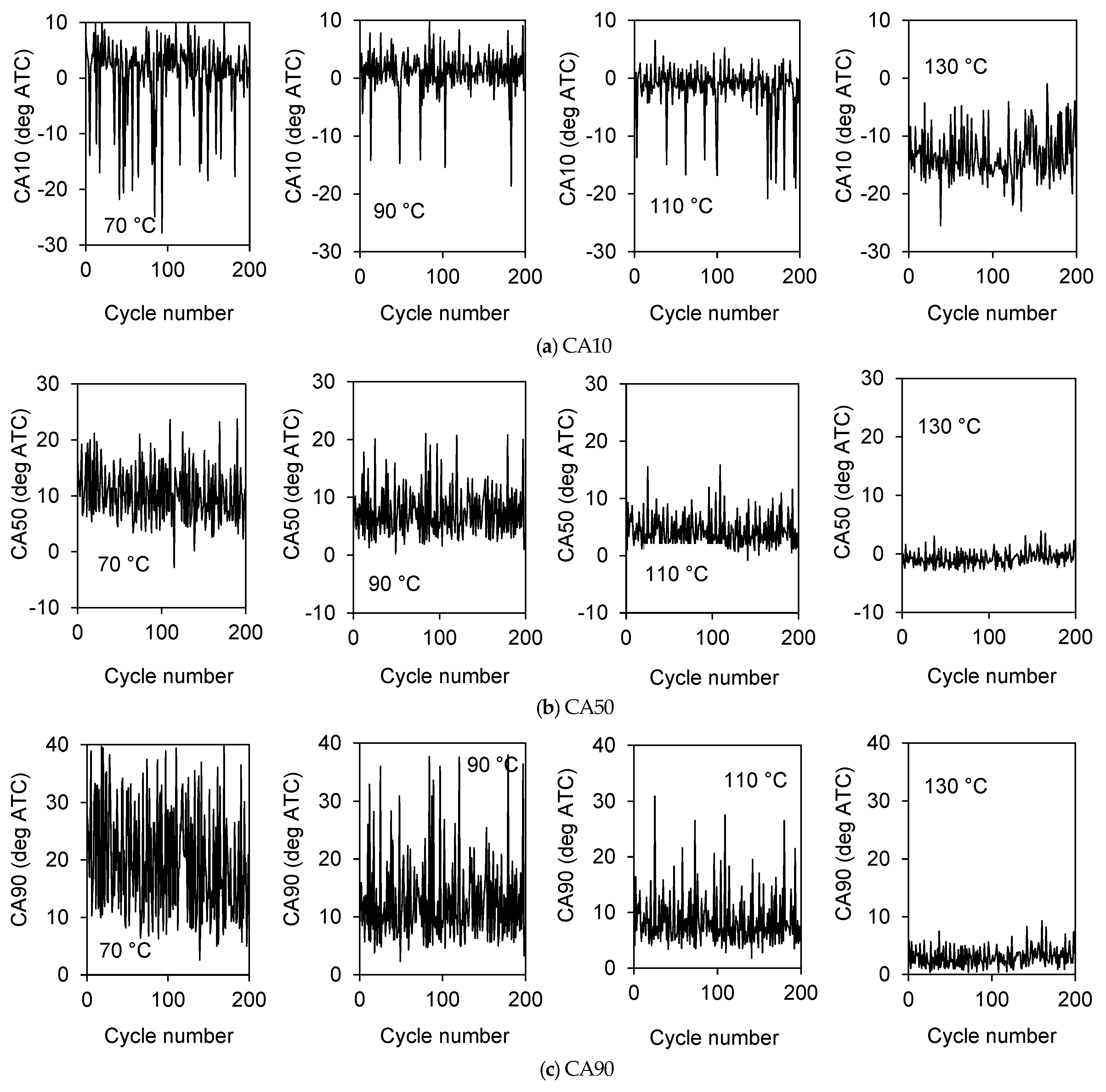
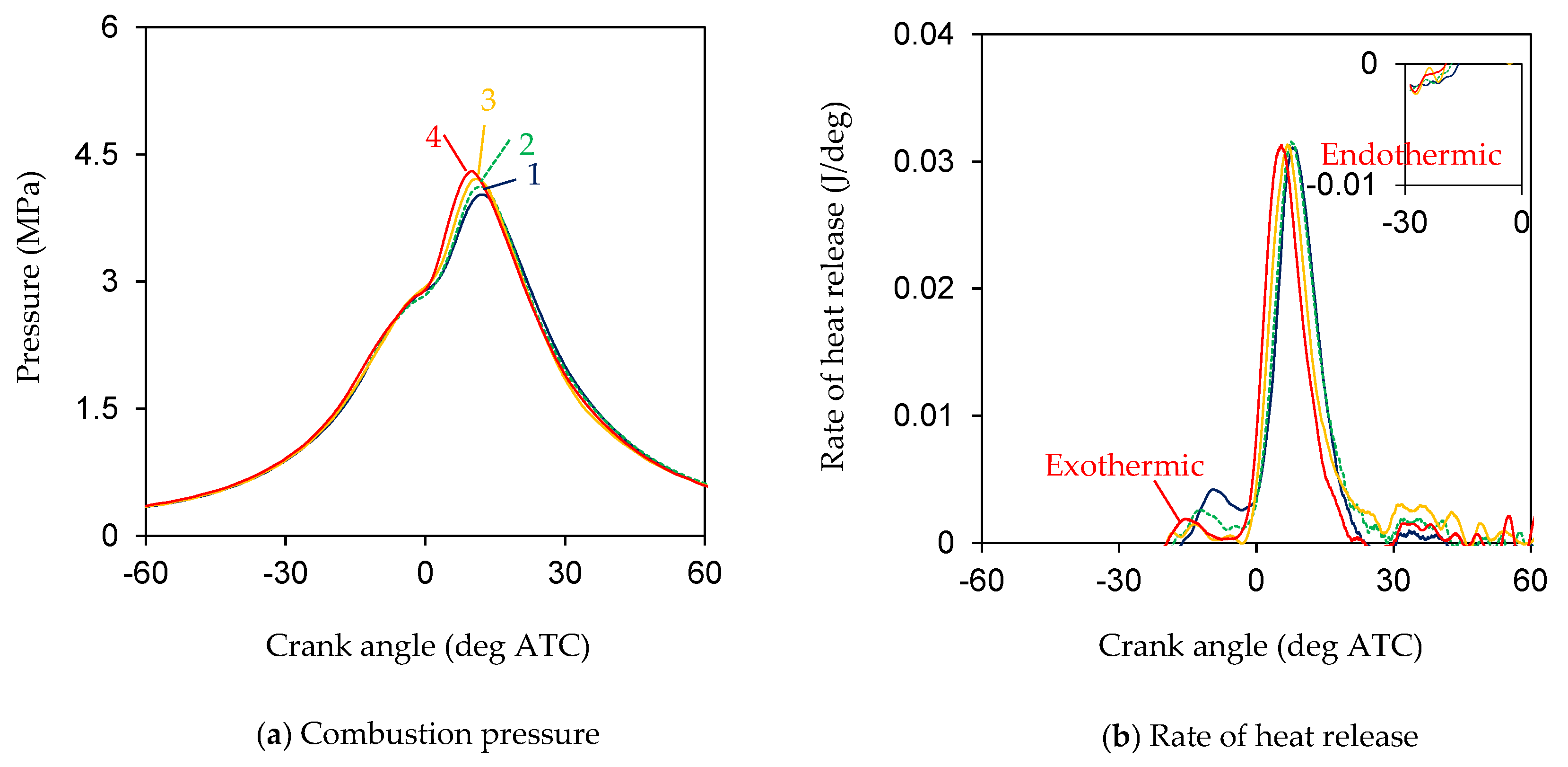
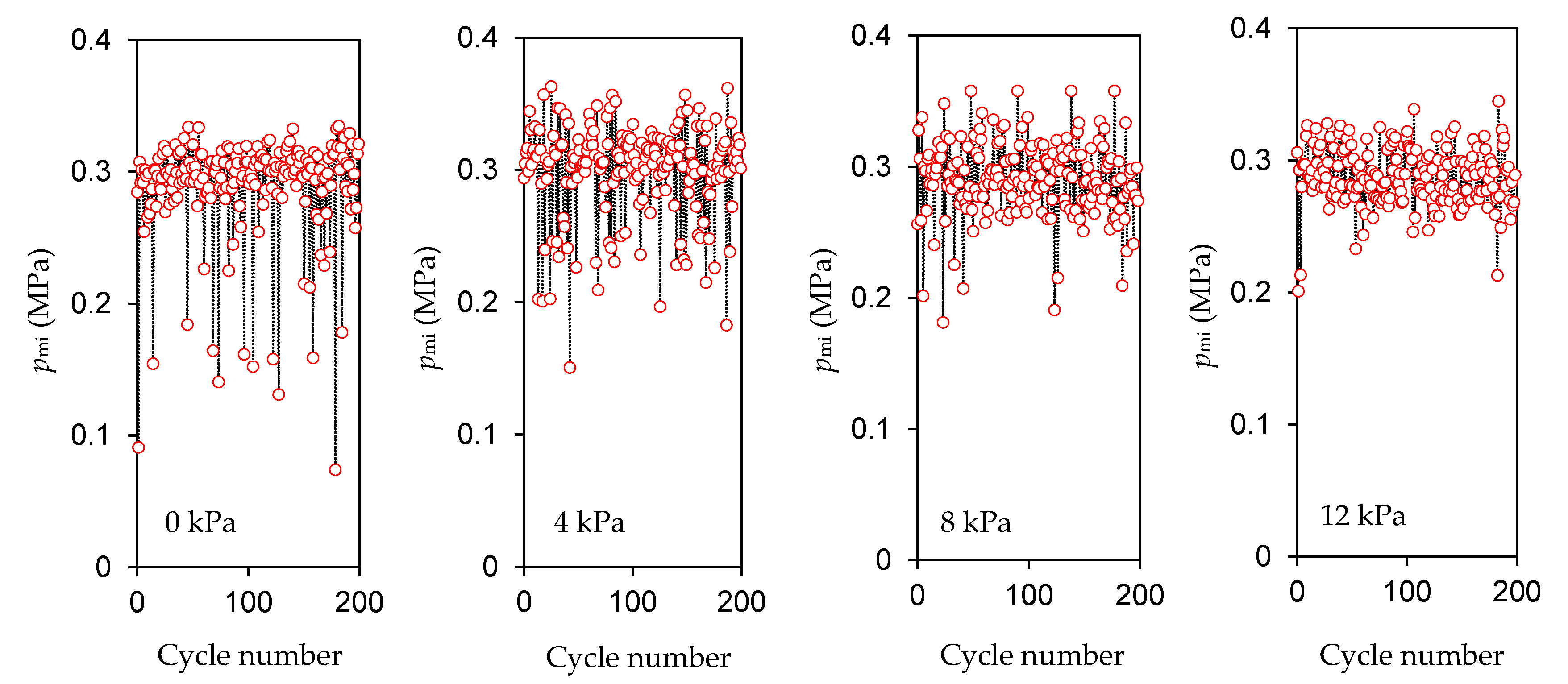

| Name | Maker | Type | Measurement Range | Accuracy |
|---|---|---|---|---|
| Pressure transducer | KISTLER Ltd. | 6052B | 0–25 MPa | ≤±0.3%/FSO |
| Crank angle sensor | ONO SOKKI | MP-935 | 0–360 deg CA | ≤±0.1 deg CA |
| K-type thermocouple | VICTOR Technology | DM6801A | −50–1300 °C | ≤±0.4 °C |
| Photoelectric tachometer | SUWEI Electronic Technology | DT2234B | 3–99,999 r/min | ≤±1 r/min |
| Flow meter | SIARGO | MF5706-N-25 | 0–25 L/min | ≤2.5% |
| Dial indicator | HENGLIANG Measuring Tools (Zhengzhou, China) | A-33 | 1–10 mm | ≤±0.01 mm |
| Fuel weighing balance | YOUHENG Weighing Equipment (Hangzhou, China) | BS600L | 0–600 g | ≤±0.15 g |
| Type | Kerosene | Diethyl Ether | Castor Oil | Isopropyl Nitrate |
|---|---|---|---|---|
| Chemical formula | C12H26 | C4H10O | C18H34O3 | C3H7NO3 |
| Heat value (MJ/kg) | 41.8 | 33.9 | 37.2 | - |
| Hexadecane value | 41.4 | >125 | - | 1200 |
| Ignition temperature (°C) | 210 | 160 | - | - |
| Number of Turns | Movement Distance (mm) | Combustion Chamber Volume (mm3) | Compression Ratio (-) |
|---|---|---|---|
| 0/8 | 0 | 9.88 | 56.4 |
| 1/8 | 0.1 | 16.24 | 34.7 |
| 2/8 | 0.2 | 22.61 | 25.2 |
| 3/8 | 0.3 | 28.97 | 19.9 |
| 4/8 | 0.4 | 35.33 | 16.5 |
| 5/8 | 0.5 | 41.69 | 14.1 |
| 6/8 | 0.6 | 48.05 | 12.4 |
Disclaimer/Publisher’s Note: The statements, opinions and data contained in all publications are solely those of the individual author(s) and contributor(s) and not of MDPI and/or the editor(s). MDPI and/or the editor(s) disclaim responsibility for any injury to people or property resulting from any ideas, methods, instructions or products referred to in the content. |
© 2024 by the authors. Licensee MDPI, Basel, Switzerland. This article is an open access article distributed under the terms and conditions of the Creative Commons Attribution (CC BY) license (https://creativecommons.org/licenses/by/4.0/).
Share and Cite
Shang, H.; Zhang, L.; Tang, Z.; Han, J.; Wang, Y.; Zhang, T. Combustion Test for the Smallest Reciprocating Piston Internal Combustion Engine with HCCI on the Millimeter Scale. Appl. Sci. 2024, 14, 7359. https://doi.org/10.3390/app14167359
Shang H, Zhang L, Tang Z, Han J, Wang Y, Zhang T. Combustion Test for the Smallest Reciprocating Piston Internal Combustion Engine with HCCI on the Millimeter Scale. Applied Sciences. 2024; 14(16):7359. https://doi.org/10.3390/app14167359
Chicago/Turabian StyleShang, Huichao, Li Zhang, Zhigang Tang, Jinlin Han, Yingzhang Wang, and Tao Zhang. 2024. "Combustion Test for the Smallest Reciprocating Piston Internal Combustion Engine with HCCI on the Millimeter Scale" Applied Sciences 14, no. 16: 7359. https://doi.org/10.3390/app14167359




